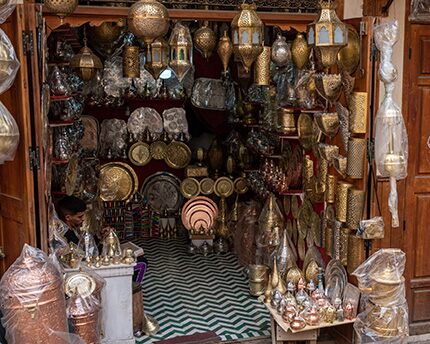If you visit the Fez Medina, you must go to the Bou Inania Madrasa, no matter what. It is one of the largest monuments in Fez, with its more than 1,500 square meters spread over two floors, and one of the few religious buildings that non-Muslims can visit in Morocco.
Once inside you will be surprised by the decorative profusion with which its builders covered practically all the public spaces, from the floor to the ceiling. Everything is built as a way of singing to a deity and awakening the feeling of spirituality both among the students who reside and are educated there and among everyone who visits the madrasa.
History of the Bou Inania Madrasa
The Bou Inania Madrasa has marked the life of the area in which it is located, the old Fez medina, since 1350. That year culminated the great dream of Sultan Abu Inan Faris of the Marinid dynasty. Since then, most of the country’s religious intellectuals have studied there.
The Bou Inania Madrasa was renovated during the 18th century, by order of Sulayman of Morocco, of the Alawite dynasty, the ruling family in present-day Morocco. Later, in the 20th century, most of the rooms were renovated, although maintaining at all times the building’s structure and the decorative profusion that its original creators gave it.
What is really a madrasa
A madrasa is a Koranic school of higher education, i.e. where students are taught to interpret the writings of the Koran and practice the Muslim religion in accordance with its precepts. Nevertheless, the literal translation of madrasa is simply “school.” So the madrasas, today as in their origin, are educational centres not only in religious matters but also in languages, law and Islamic laws, medicine, history, mathematics, astronomy and music.

In some way, the concept of madrasa could be equated with that of major seminaries or even with European university schools. Although it is true that in Morocco, as in the rest of the Maghreb and other countries in the Islamic world, there are university schools as such.
Things to see inside the Madrasa
Firstly, remember that the Bou Inania Madrasa continues to fulfil its function as an educational centre. This means that, in addition to the educational activities that take place there, the upper part of this monument serves as a residence for its students. Therefore, that area cannot be accessed.
Nevertheless, you can visit part of the mosque since it is one of the few buildings of Islamic worship that non-believers can access. What you can admire is the large central courtyard that lays out the entire building, which is also one of the most spectacular and detailed spaces in the entire madrasa.

There, apart from the arches and plaster decoration on the walls (see below), the round fountain in the middle, decorated with aquatic motifs, will draw your attention. It is fed by the fresh waters of the river Oued Fes, directly from the nearby mountains.
Curiosities and details not to be missed
The most striking thing about the Bou Inania Madrasa is the rich decoration in plaster and stucco that covers most of its walls. Next to the fountain, worked tile plinths in bright colours and carved wooden ceilings leave all visitors speechless. Pay attention to the vegetable and astronomical details that decorate the capitals of the columns as well as the Arabic inscriptions on the walls, which reproduce texts from the Koran. Also focus on the muqarnas, which are very common in the Nasrid culture of Granada (and later in the Marinid culture of Morocco), that hang from many of the curved structures of the building.

Also very striking is the ceramic covering of the mosque’s minaret. When the sun’s rays hit the polished tiles, they emit sparkles that attract the attention of both the visitors to the madrasa and the passers-by outside.
Once outside, pay attention to the water clock that decorates the façade and is known as the Dar al-Magana clepsydra.
Information of interest
You can visit the Bou Inania Madrasa every day of the week, with the exception of Friday, a day of prayer for Muslims and when many of the public buildings remain closed. Visiting hours are from 9.00 a.m. to 6.00 p.m., with two hours closed at midday. Remember that public access is not allowed during the minutes that the various daily prayers last. This is because the Bou Inania Madrasa is considered to be a “grand mosque” and, therefore, a spiritual reference for the inhabitants of the neighbourhood in which it is located.
The entrance price is 20 dirhams, i.e. just under 2 euros. Since it is a place of spirituality, remember to avoid wearing flashy or too light clothing.
We highly recommend visiting the madrasa outside the peak hours of visitors and students (especially before lunch). In that way, you can let yourself be carried away by the peaceful atmosphere that this monument exudes and listen to the evocative sound of the water from the fountain in the central courtyard.


















































































